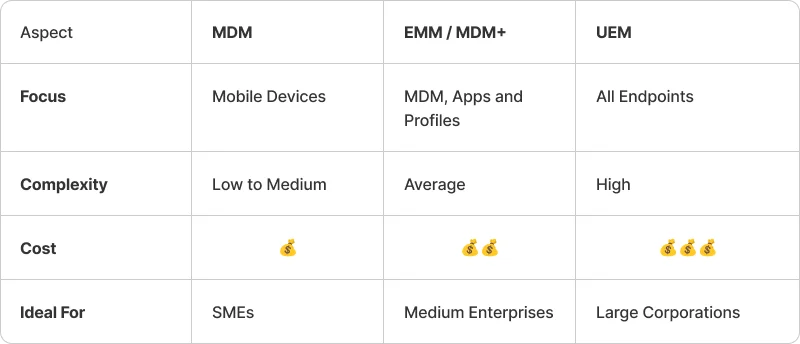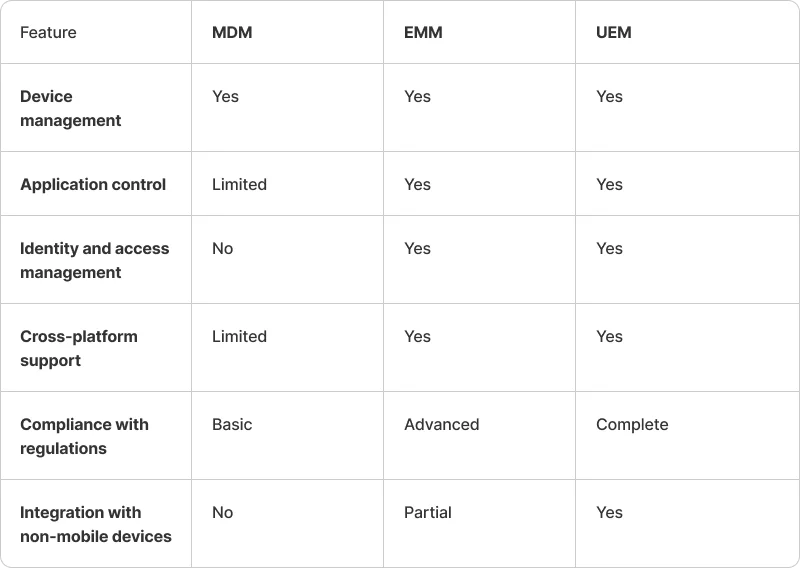Mobile device management has become a strategic necessity for companies seeking security, efficiency, and control over their digital assets. But with so many options on the market, how do you choose the right solution? MDM, EMM, and UEM are terms that are often used, but they have fundamental differences. In this article, we explore these differences so you can make an informed decision.

What is MDM (Mobile Device Management)?
MDM software is the foundation of mobile device management. Its primary focus is on controlling the hardware itself. Think of it as the fundamental management of the device.
It allows companies to configure, monitor and protect corporate devices, whether they are smartphones, tablets or other mobile devices. Its main features include:
- Remote control of devices;
- Application of security policies;
- Remote data blocking and wiping;
- Restricting applications and device functionality.
However, MDM has some limitations as it focuses primarily on device management and may not encompass application control and user identity, which are essential in more complex enterprise environments.
Although the name "Nomid MDM" emphasizes the term Mobile Device Management, the solution goes far beyond the basic features of a traditional MDM. Like many modern platforms, Nomid MDM includes all the capabilities expected of a full EMM solution — including application control, corporate security, content management, and integrations with identity and corporate policy systems.
Keeping the term MDM in the name is a strategic choice aimed at facilitating finding our brand and product in online searches, and understanding what it does, because "MDM" is still widely used as the main word to describe this type of software.
Read our in-depth article on what is MDM and it's key benefits here
What is EMM (Enterprise Mobility Management)?
Enterprise Mobility Management (EMM) expands on the capabilities of MDM, providing a more comprehensive approach to security and mobility management. In addition to device management, it includes:
- MAM (Mobile Application Management): Allows you to manage specific corporate applications: distribute apps (private or public), configure policies within apps (such as preventing copy/paste to personal apps), and wipe data only from corporate apps without affecting personal data (essential for BYOD).
- MCM (Mobile Content Management): Ensures secure access to corporate documents and files through a secure repository, with sharing and permissions control.
- MIM (Mobile Identity Management) : Manages user access to corporate resources from mobile devices, often integrating with existing identity solutions and enabling single sign-on (SSO).
- Integration with compliance policies such as LGPD and GDPR.
EMM is ideal for companies that need to ensure not only the security of devices, but also the protection of data and applications used by employees.
What is UEM (Unified Endpoint Management)?
Unified Endpoint Management (UEM) is the next evolution of device management solutions. It unifies control of all enterprise endpoints, not just mobile devices, but also computers, laptops, IoT, and other connected devices.
The main advantages of UEM include:
- Unified management of all devices, regardless of operating system;
- Centralized endpoint monitoring and protection;
- Automation of security and compliance tasks;
- Better integration between devices and enterprise applications.
UEM is suitable for organizations that have a diverse infrastructure and seek centralized management of all their devices.
Comparison: MDM vs. EMM vs. UEM

How Nomid MDM Helps IT Managers:
- Simplifying Mass Provisioning : With Zero Touch Enrollment , setting up hundreds of Android devices becomes an automated and error-proof process, essential for companies with large field teams or logistics operations. Forget manual configuration!
- Robust, Adaptive Security Implement granular security policies, from requiring strong passwords to setting up VPNs and app restrictions. For industries like Education and Industry , where data security is critical, Nomid offers extra layers of protection, including integration with Samsung Knox .
- Full Control for Specific Use Cases : Need dedicated devices for a single purpose, such as point-of-sale in Retail or work tools in Services ? The Nomid Kiosk allows you to lock your device to one or more specific apps, ensuring proper usage and security.
- Efficient Remote Support : Reduce downtime and travel costs. With Remote Control , your IT team can view the screen and control Android devices remotely to quickly troubleshoot issues.
- Intelligent Application Management : Distribute corporate applications (public or private) securely, control versions and ensure your team always has the right tools, updated and configured.
- Focus on the IT Manager Experience: Nomid MDM was designed with the reality of the IT manager in mind, offering an intuitive interface in English, Portuguese and Spanish, and specialized support for the nuances of the local market and the Android ecosystem.
Rather than a generic UEM solution that tries to cover everything, Nomid MDM offers depth and expertise where it matters most to most companies: in the effective, secure and simplified management of their Android assets.
Now that we understand the options, how do you decide which solution – MDM, EMM, UEM, or a specialized solution like Nomid MDM – is right for your company? The answer lies in a careful analysis of your specific needs:
Which solution to choose for your company?
The choice between MDM, EMM and UEM depends on your company's needs:
- MDM : Recommended for companies that need basic mobile device management and security policy control.
- EMM : Ideal for companies that prioritize data and application security, in addition to user identity management.
- UEM : Recommended for organizations that want unified management of all corporate devices, regardless of platform.
Steps to the Right Choice
- Evaluate your Device Fleet:
- What types of devices do you need to manage? Only mobile (Android, iOS)? Or also desktops, laptops, IoT?
- What is the predominance? If the majority are Android, a specialized solution like Nomid may be more effective and cost-effective.
- What is the ownership model? Are these corporate-owned devices (COD), personal devices allowed for work (BYOD), or a mix?
- Define your Security Requirements:
- How sensitive is the data accessed by the devices?
- Do you need just basic control (passwords, remote lock) or granular application and data management (MAM, MCM)?
- What are the specific compliance requirements (LGPD, sectoral regulations)?
- Consider User and IT Needs:
- Do users need access to specific applications? Is it necessary to separate personal and corporate data on BYOD devices?
- How skilled is your IT team? A unified user interface (UEM) can simplify the management of multiple device types, but a specialized solution may be easier to master for a focused environment.
- How important is remote support and task automation?
- Think about the Future and Scalability:
- What are the company's growth plans in terms of number of devices and employees?
- Will device diversity increase or will it remain focused on one main platform?
Implementation Best Practices :
- Define Clear Policies : Before implementing, clearly define your usage, security and privacy policies.
- Communicate with your Users : Explain why the solution is needed and how it will affect their device usage.
- Implement in Phases : Start with a pilot group before expanding to the entire organization.
- Train your IT Team : Ensure that the responsible team is able to manage the tool.
- Monitor and Adjust : Regularly review your policies and configurations to ensure they remain effective and aligned with business needs.
Conclusion
Choosing the right solution is essential to ensuring the security and operational efficiency of your company. Evaluate your needs, infrastructure, and long-term goals before making a decision.
Navigating the world of mobile device management can seem overwhelming with so many acronyms – MDM, EMM, UEM. As we’ve seen, each represents a stage in the evolution of management, from basic device control (MDM) to unified management of all endpoints (UEM).
Nomid MDM offers a robust and intuitive solution for mobile device management, ensuring security, compliance and efficiency for your business. Request a demo and find out how we can help you optimize your corporate device management.
Ready to simplify and secure the management of your Android devices?
Explore how our solution, recognized as an Android Enterprise Silver Partner, can transform mobile device management in your enterprise.
Request a Free Demo of Nomid MDMShare this article
Tags
- #mdm emm uem


